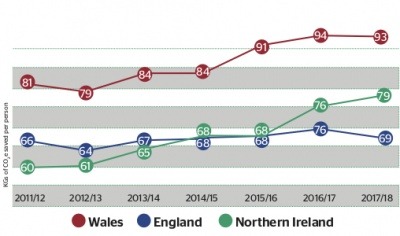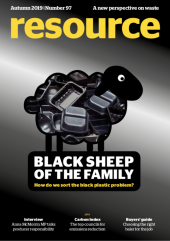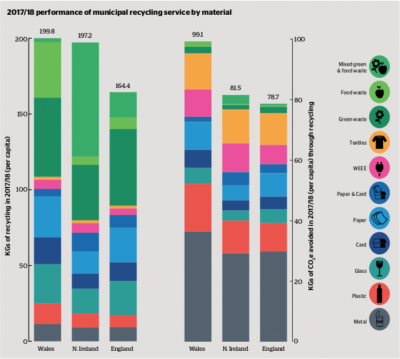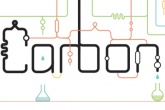Carbon Index 2019: Northern Irish councils make strides in carbon reduction
Peter Jones, Senior Consultant at Eunomia Research and Consulting, presents the results from the seventh Local Authority Recycling Carbon Index, showing who’s surging ahead in the fight to limit carbon emissions

Record-breaking temperatures, ferocious forest fires and volatile weather over a sweltering and turbulent summer should leave no one in any doubt that we are currently in the midst of a climate emergency. We face a race against time to reign in runaway carbon emissions. This is a challenge for every strata of society, from individual residents to businesses and government of all levels. The management of resources and waste by local authorities has a key part to play in this, with the recycling of different materials saving a varying amount of carbon emissions.
Northern Ireland’s councils increased the amount of CO2 equivalent emissions (CO2e) they saved through recycling in 2017/18, while Wales’ and England’s performance dropped. That’s the finding from Eunomia’s latest update to the annual Local Authority Recycling Carbon Index, which uses carbon factors to compare the amount of CO2e saving per capita that each achieves through recycling.
The Carbon Index is based on tonnages reported by councils through WasteDataFlow for 2017/18, combined with ‘per tonne’ carbon savings estimates for a range of recyclables derived from Zero Waste Scotland’s Carbon Metric. It covers waste disposal authorities in England, Wales and Northern Ireland – unfortunately, Scottish authorities report annually on a calendar year basis, making it impossible to compare their results with the rest of the country on a consistent basis.

The Carbon Index provides an alternative to tonnage-based recycling rates in assessing the performance of councils’ collection systems – something that the Department for Environment, Food and Rural Affairs (Defra) has suggested is an important way to gain better insight into the environmental benefit achieved through recycling.
When set against tonnage-based data, the Index can give rise to particularly interesting points of comparison. For example, there is very little difference in the quantity of material collected for recycling per capita in Wales and Northern Ireland; however, in Wales, a greater share of this material is dry recycling rather than organics, resulting in considerably greater emissions savings.
Looking at each country’s overall performance, Northern Ireland has improved by 3.2 points (4.2 per cent), reflecting a 3.8 percentage point (8.4 per cent) increase in the recycling rate to 48.1 per cent. Meanwhile, Wales’ emissions performance fell by 0.2 points, while England’s dropped by 0.7 points, leaving it well behind its neighbours. Both countries also saw small falls in their tonnage-based recycling rate.
Northern Ireland’s best-performing individual authority was Antrim and Newtownabbey, which managed to achieve an emissions saving of 98 kilogrammes (kg) CO2e per person. The authority became the first Northern Irish authority ever to feature in the Index’s ‘High Flyers’ – the rank reserved for the top 10 per cent – and was considerably ahead of its nearest competitor, Mid Ulster.
England’s leading authority was the Dorset Waste Partnership with 108kg CO2e saved per person. The margin over second and third place was just 1kg CO2e, with both Gloucestershire and Cheshire West and Chester achieving savings of 108kg CO2e.
However, for the third successive year, a Welsh authority can lay claim to the title of the biggest emissions preventer. Merthyr Tydfil switched to weekly multistream collections with separate food waste and reduced the size of its residual waste bins in 2015. Since then, it has risen up the index and leapt from seventh place in 2016/17 to take the lead with 117kg CO2e saved per person in 2017/18, an increase of 13kg. In fact, Welsh authorities occupied all of the top five, and six of the top ten positions in the Index.
 This article was taken from Issue 97
This article was taken from Issue 97
Wales can also take credit for this year’s most improved authority. Bridgend increased its carbon savings per person from 95kg to 114kg, an increase of 19kg. Merthyr Tydfil was the second most improved authority, with its 13kg increase. Meanwhile, the third biggest increase was at the opposite end of the Index: England’s Bradford increased its performance by 12kg CO2e per person, reaching 46kg, after switching from weekly to fortnightly residual waste collections in 2017.
However, ten of Wales’ 22 authorities saw their performance fall in 2017/18, as did 80 out of the 134 authorities in England – despite the growing awareness of waste and recycling issues that emerged during the year. It seems likely, though, that the implementation of England’s Resources and Waste Strategy and the pressure of Wales’ next binding recycling targets will help to reverse this trend.

The full report can be downloaded from the Carbon Index website at http://www.eunomia.co.uk/carbonindex. The site
also includes a tool where every local authority’s historical performance can be viewed; this also allows for the comparison of any two authorities’ performance. 








